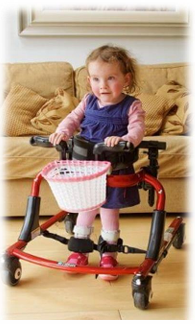Action Medical Research for Children
Background
With thanks to support from The James & Grace Anderson Trust, Action Medical Research supported a team of orthopaedic surgeons, based in Oxford, to investigate whether a surgical procedure called Single Event Multi-Level Surgery is always the optimum treatment choice to repair bone and join deformities in children who are disabled by cerebral palsy. The project recently ended and following data analysis, we are pleased to report the findings of this study to the Trustees. We are very grateful for your support towards this important work.
Cerebral Palsy
Cerebral palsy is a lifelong condition caused by damage to the brain before or during birth. It is the most common serious physical problem in children, estimated to affect more than 1,500 babies born in the UK each year. Children with cerebral palsy develop stiff muscles and bone and joint deformities which affect how they move and function in their daily lives. In approximately a third of these children, the condition mainly affects their legs making walking difficult, and in some cases, impossible.
Diplegia is a form of cerebral palsy that predominantly affects the legs and restricts the ability to walk; it is this form of cerebral palsy that is most suited to treatment through a type of orthopaedic surgery known as SEMLS.
Single Event Multi-Level Surgery
SEMLS is essentially multiple surgeries carried out in one operation, often taking as long as a day, with one rehabilitation period, thus reducing the need for repeated episodes of limited surgery and resulting rehabilitation. Surgery can help children overcome some of these difficulties by correcting the muscle, bone, and joint deformities. SEMLS is widely used in the UK and, when successful, has the potential to limit the impact of children’s disability for a lifetime. There is variation in practice and quality standards across centres and little evidence in medical literature on the effectiveness of SEMLS; this leads to conflicting information and a loss of confidence in the procedure for families for whom it is an option.
The research project
This Action Medical Research funded study collected information on children undergoing SEMLS in the UK over a period of over 2 years. The research team obtained information from 203 children from 22 surgical centre across the UK providing this type of surgery. Recruitment to the study ended on 31st March 2022 and the research team followed up how the children are doing for a further 2 years, by talking to the surgeons and the families of the children. The focus was on what mattered for children and their families. The study demonstrated that SEMLS improved the way children walked: this was measured by computerised gait analysis. The parents and carers who were surveyed thought there were significant improvements in their children’s walking. However, there were no significant gains in their overall physical ability - that is, how far or how fast they could walk. In comparison to children who did not undergo this type of surgery, children who underwent SEMLS had significant improvements in their walking patterns.
Impact
The findings of this research project have clearly shown what results can be expected after SEMLS. This will guide clinicians and parents/carers when deciding whether to proceed with SEMLS or not. The study has demonstrated significant variation in practice among the centres undertaking SEMLS. There is particular variation in how they select children for the treatment and how they measure outcomes. The study identified areas where further research would help reduce variation in practice and improve outcomes. Previous research in this field included single-centre cohort studies. There was no previous national surveillance study of this type of practice. The findings of this study – the first ever national study of orthopaedic surgery for children with cerebral palsy in the UK - provide robust evidence that gait analysis parameters improved following SEMLS but overall motor function remained unchanged. This study was prioritised as one of the top-10 research priorities in children’s orthopaedics in a Delphi consensus amongst BSCOS members (British Society for Children’s Orthopaedic Surgery). This research was also prioritized as number 3 at a recent James Lind Alliance Priorities Setting Partnership on paediatric lower limb surgery. This highlights the importance of this project for both the patients and clinicians. The results of this research project will be disseminated nationally and internationally within the next 12 months. A scientific paper is being prepared for a peer reviewed journal of high impact. Benchmarking against the results of the research project will be made possible and it is likely to be adopted by the profession - at least in the UK - within this 12 month timeframe. Further research by this team, sponsored by NIHR, will commence in the next 18 months.
The James and Grace Anderson Trust
Thanks to the Trust generous support, Action Medical Research has facilitated the first ever national study of orthopaedic surgery for children with cerebral palsy in the UK. The outcomes from this study will help children and their families to better understand the benefits of this type of surgery. It will also help surgeons to improve how SEMLS is performed and select the best type of surgery and rehabilitation for individual children.
Pictured: Alice, who has cerebral palsy causing movement difficulties in her torso and limbs.


